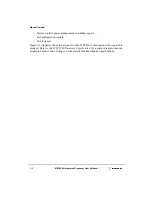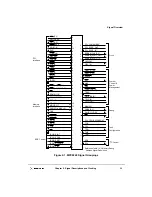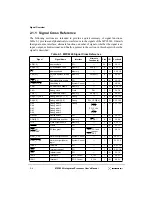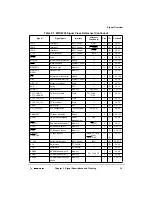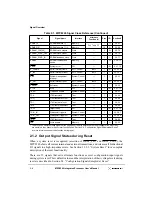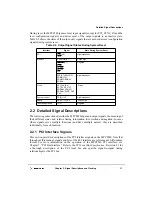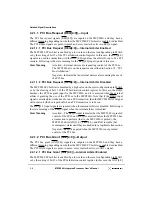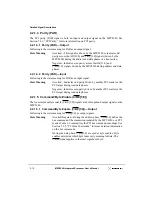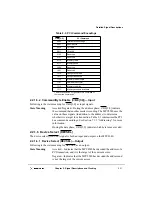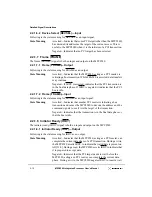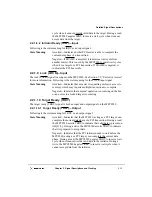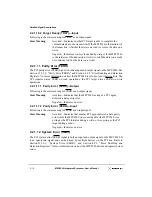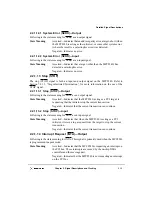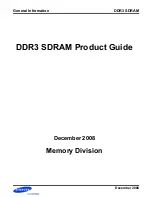
1-20
MPC8240 Integrated Processor User’s Manual
Debug Features
1.7.1 Memory Attribute and PCI Attribute Signals
The MPC8240 provides additional information corresponding to memory and PCI activity
on several signals to assist with system debugging. The two types of attribute signals are
described as follows:
•
The memory attribute signals are associated with the memory interface and provide
information concerning the source of the memory operation being performed by the
MPC8240.
•
The PCI attribute signals are associated with the PCI interface and provide
information concerning the source of the PCI operation being performed by the
MPC8240.
1.7.2 Memory Debug Address
When enabled, the debug address provides software disassemblers a simple way to
reconstruct the 30-bit physical address for a memory bus transaction to DRAM and
SDRAM, ROM, FLASH, or PortX. For DRAM or SDRAM, these 16 debug address signals
are sampled with the column address and chip-selects. For ROMs, FLASH, and PortX
devices, the debug address pins are sampled at the same time as the ROM address and can
be used to recreate the 24-bit physical address in conjunction with ROM address. The
granularity of the reconstructed physical address is limited by the bus width of the interface;
double-words for 64-bit interfaces, words for 32-bit interfaces, and bytes for 8-bit
interfaces.
1.7.3 Memory Interface Valid (MIV)
The memory interface valid signal, MIV, is asserted whenever FPM, EDO, SDRAM,
FLASH, or ROM addresses or data are present on the external memory bus. It is intended
to help reduce the number of bus cycles that logic analyzers must store in memory during
a debug trace.
1.7.4 Error Injection/Capture on Data Path
The MPC8240 provides hardware to exercise and debug the ECC and parity logic by
allowing the user to inject multi-bit stuck-at faults onto the peripheral logic or memory
data/parity buses and to capture the data/parity output on receipt of an ECC or parity error.
1.7.5 IEEE 1149.1 (JTAG)/Test Interface
The processor core provides IEEE 1149.1 functions for facilitating board testing and
debugging. The IEEE 1149.1 test interface provides a means for boundary-scan testing the
processor core and the board to which it is attached.
Summary of Contents for MPC8240
Page 1: ...MPC8240UM D Rev 1 1 2001 MPC8240 Integrated Processor User s Manual ...
Page 38: ...xviii MPC8240 Integrated Processor User s Manual TABLES Table Number Title Page Number ...
Page 48: ...xlviii MPC8240 Integrated Processor User s Manual Acronyms and Abbreviations ...
Page 312: ...6 94 MPC8240 Integrated Processor User s Manual ROM Flash Interface Operation ...
Page 348: ...7 36 MPC8240 Integrated Processor User s Manual PCI Host and Agent Modes ...
Page 372: ...8 24 MPC8240 Integrated Processor User s Manual DMA Register Descriptions ...
Page 394: ...9 22 MPC8240 Integrated Processor User s Manual I2O Interface ...
Page 412: ...10 18 MPC8240 Integrated Processor User s Manual Programming Guidelines ...
Page 454: ...12 14 MPC8240 Integrated Processor User s Manual Internal Arbitration ...
Page 466: ...13 12 MPC8240 Integrated Processor User s Manual Exception Latencies ...
Page 516: ...16 14 Watchpoint Trigger Applications ...
Page 538: ...B 16 MPC8240 Integrated Processor User s Manual Setting the Endian Mode of Operation ...
Page 546: ...C 8 MPC8240 Integrated Processor User s Manual ...
Page 640: ...INDEX Index 16 MPC8240 Integrated Processor User s Manual ...

















